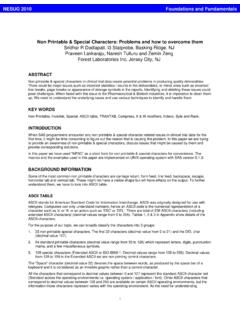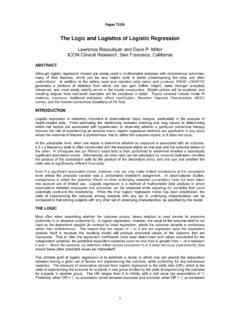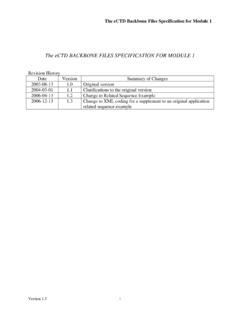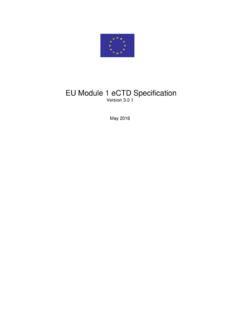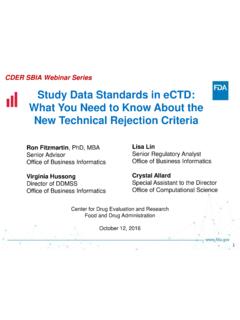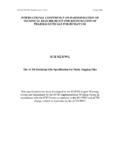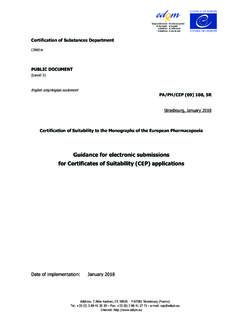Transcription of CDISC rules + FDA requests + PMDA requirements ...
1 Page 1 The PhUSE name and logo are the property of PhUSE Copyright 2019 Covance Inc. Paper SI12 PhUSE US Connect 2019 CDISC rules + FDA requests + PMDA requirements = Guaranteed Compliance? Deb Goodfellow, Covance, King of Prussia, PA, USA ABSTRACT With more emphasis being placed on standardization of clinical trials data, an abundance of information must be considered by those involved in the preparation of submissions. This information is provided by multiple regulatory agencies and standardization groups.
2 How do we interpret this information to develop a compliant submission? What exactly constitutes a compliant submission? Depending on when and where the submission is to be sent, the path to compliance could be dramatically different. For example, the Pharmaceuticals and Medical Devices Agency (PMDA) and the Food and Drug Administration (FDA) have different rules for determining compliance, different versions of implementation guides and validation tools as well as different dates for when new versions of a standard are required.
3 This paper will address some examples where the regulatory requests and the available standards seemingly contradict each other. In addition, ideas are presented on what constitutes compliance and how to determine whether a particular interpretation of compliance is actually compliant. INTRODUCTION rules , requests , requirements , standardization committees, regulatory agencies and more - Preparing for a submission requires knowledge, interpretation and implementation of many factors. It is difficult at best to incorporate and consolidate this information, but seemingly impossible when we consider that changes and development are ongoing within the standards and agencies.
4 In order to create a compliant submission, the definition of compliance for the planned submission needs to be determined. This paper will present some of the differences in requirements between and within PMDA and FDA that need to be addressed and some of the difficulties in interpretation of the requirements . rules may differ from what is presented depending on the study design such as phase, integration studies, legacy studies, etc. Always refer to the latest guidance from the regulatory agency as applicable for the submission.
5 TIMING AND VERSIONING OF STANDARDS The current requirements for a submission must be determined using the applicable date as specified by the agency. The below table has the date of the agency-initiated requirements for standardized submissions. The definition for the start of the requirement period applies to both the initial standards implementation and updates to existing standards required for the submission. Agency Initial Standards Requirement Date Determination of Requirement Start Date FDA December 17, 2016 The requirement to submit using a particular standard is dependent on its support by FDA as listed in the Catalog at the time of study PMDA April 1, 2020 The base date is the submission date recorded by the applicant on the FD application of the new drug application form.
6 2 Until April 1, 2020, PMDA is in a transitional phase. During the transitional phase, certain electronic data may be submitted and will be subject to all current applicable rules . When submitting electronic data, both SDTM and ADaM (ADaM when required for analyses) must be submitted for the entire study if implemented during this Both FDA and PMDA have their currently accepted versions of standards in their respective Data Standards Catalog. 4, 5 The standard and the date to which it applies is documented in the catalog along with other information.
7 When Page 2 The PhUSE name and logo are the property of PhUSE Copyright 2019 Covance Inc. multiple versions of a standard are accepted, it is best practice to use the newest version. For FDA submissions, the version at the study start will be compliant regardless of the date of submission but using the latest version will provide the most complete implementation and guidance. For PMDA submissions, it is possible that support for that version would end prior to submission which could necessitate updates in order to remain compliant.
8 COMPLIANCE In order to plan a compliant submission, it is necessary to be aware of the checks the agency will do when the submission is delivered. Prior to delivery, validation should be performed to identify and resolve any issues that the agency has identified that may lead to rejection of the submission. These issues are identified in the standards requirements published by the agency. At times it may be difficult to determine the proper implementation of compliance requirements . There are multiple versions of guidance documents, multiple documents that cover related items, documents with circular references to each other, and more!
9 There are instances where the related documents seemingly conflict what is the compliant choice? If the standard says something should be done a certain way rather than must , is it non-compliant if it is not? When differences are found in guidance documents it is important to know which should be followed. Possible considerations can be based on the publication dates of the conflicting documents, dates when the document is applicable, what type of study is involved and the type of the document. For example, the FDA Technical Conformance Guide (TCG) 6 and the Study Data Tabulation Model Implementation Guide (SDTMIG) 7 differ in the values for populating (or not populating) the variable ARM in DM (Demographics dataset).
10 FDA documents are not always required to be followed. Typically documents that can be considered guidance rather than requirements will specify within the document that it contains nonbinding recommendations. Typically, documents that refer to statutes and regulations are requirements that must be followed. The FDA TCG does, in fact, contain nonbinding information. CONFORMANCE CHECKS PERFORMED BY AGENCY With the initial submission, the FDA focuses more on the technical aspect of the submission, while the PMDA includes additional checks for compliance to Clinical Data Interchange Standards Consortium ( CDISC ) standards 8.






